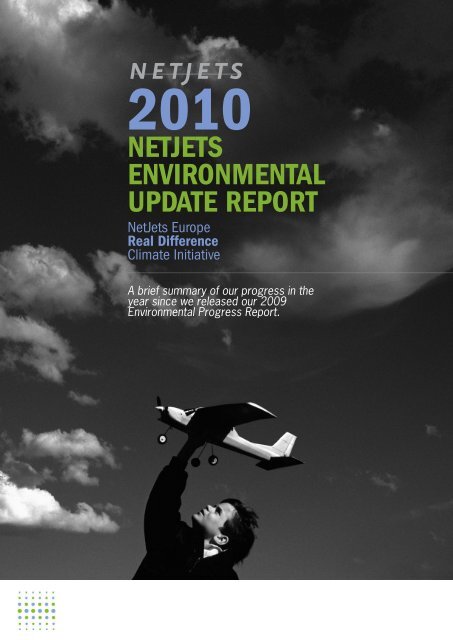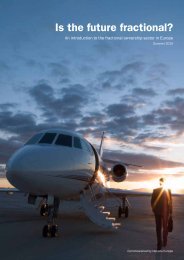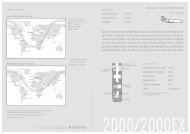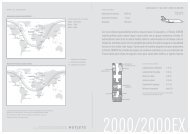Download the full report - NetJets Europe
Download the full report - NetJets Europe
Download the full report - NetJets Europe
- No tags were found...
You also want an ePaper? Increase the reach of your titles
YUMPU automatically turns print PDFs into web optimized ePapers that Google loves.
2010NETJETSENVIRONMENTALUPDATE REPORT<strong>NetJets</strong> <strong>Europe</strong>Real DifferenceClimate InitiativeA brief summary of our progress in <strong>the</strong>year since we released our 2009Environmental Progress Report.
2010ENVIRONMENTALUPDATE<strong>NetJets</strong> <strong>Europe</strong> Real Diff02
2010ENVIRONMENTALUPDATELetter from <strong>the</strong> Chairman and Chief ExecutiveAs <strong>the</strong> leader in business aviation, <strong>NetJets</strong><strong>Europe</strong> feels a profound responsibility tominimise <strong>the</strong> environmental impact of airtravel. Keenly aware that ours is a pollutingindustry, we faced <strong>the</strong> challenge head on,and set out three years ago to become <strong>the</strong>world’s most environmentally responsiblebusiness aviation company by launching ourReal Difference Climate Initiative.We are ahead of schedule in meeting our first environmentalcommitment: to become 100% carbon neutral by October2012. As of October 2010, we actively offset emissions for73% of our flight hours and for all internal operations. Wehave also exceeded our second commitment—to reduceemissions from office operations by 10% over two years—withan actual reduction of 25.9% per non-crew employee. Theseresults could not have been achieved without <strong>the</strong>enthusiastic support of our Owners, employees, andpartners. 1Our fuel working group continues to identify andimplement a wide range of practices that are resulting insignificantly greater fuel efficiency in our flights. During<strong>the</strong> twelve-month period ending this October, weachieved a 4.1% reduction in fuel use per flight hour,largely due to flying at slower speeds duringnon-revenue flights as well as operational proceduresand techniques.We have met and continue to meet all our monitoringand <strong>report</strong>ing obligations as we prepare for ourcompany’s inclusion in <strong>the</strong> EU Emissions TradingScheme.In late 2009, <strong>NetJets</strong> <strong>Europe</strong> acquired a majorityinterest in Frankfurt-Egelsbach Airport, which has addedto our environmental challenges and opportunities.While our support for <strong>the</strong> initial phase of <strong>the</strong> PrincetonNext Generation Fuel Project has ended, we remaincommitted to finding ways to support <strong>the</strong> developmentand use of alternative fuels.Like many companies globally, <strong>NetJets</strong> <strong>Europe</strong> hasexperienced business volatility over <strong>the</strong> past two years.Because efficiencies depend in part on economies of scale,some areas of our business experienced slightly lowereco-efficiency (on a per flight or per employee basis). Thesefluctuations are to be expected; in spite of <strong>the</strong>se challenges,Real Difference has continued to progress over <strong>the</strong> past year.This update provides a brief summary of our environmentalefforts and results since we released our first EnvironmentalProgress Report in 2009. Interested readers can refer to that<strong>report</strong> for fur<strong>the</strong>r context. We expect to issue ano<strong>the</strong>rcomprehensive <strong>report</strong> in 2011. A few items are worth noting:Through our carbon offset programme, <strong>NetJets</strong> <strong>Europe</strong>and our Owners have allocated €4.8 million for <strong>the</strong>purchase of carbon credits and supported some of <strong>the</strong>highest-quality alternative energy projects around <strong>the</strong>world. More than 80% of our Owners are currentlyparticipating in <strong>the</strong> programme.<strong>NetJets</strong> <strong>Europe</strong> remains proud of its overall environmentalrecord and is committed to fur<strong>the</strong>r improvement. We areproud to have set ourselves a number of new environmentalgoals, which cascade throughout our organisation. Notably,we aim to fur<strong>the</strong>r reduce our carbon emissions per flight hourby 2% in 2011, through operational improvements. We alsocommit to announcing a set of annual targets next year foremissions reductions until 2015. Each employee is taskedwith achieving <strong>the</strong>ir own set of goals and toge<strong>the</strong>r we believewe can make small changes that create a real difference.With <strong>the</strong> firm support of our Owners and everyone in ourcompany, we will continue to set a high bar forenvironmentally responsible flying.Sincerely,Eric ConnorChairman and Chief Executive, <strong>NetJets</strong> <strong>Europe</strong>December, 20101 Throughout this <strong>report</strong>, <strong>the</strong> term Owners refers to all of <strong>NetJets</strong> <strong>Europe</strong>’s customers, including fractional aircraft owners and Private Jet Card holders.04
05Eric ConnorChairman and Chief Executive, <strong>NetJets</strong> <strong>Europe</strong>
2010ENVIRONMENTALUPDATEClimate Change andCarbon Management<strong>NetJets</strong> <strong>Europe</strong>’s Climate Initiative has focused primarily on our greenhouse gas emissions (GHG). Based on<strong>the</strong> Greenhouse Gas Protocol, <strong>NetJets</strong> <strong>Europe</strong> has created a comprehensive profile of its greenhouse gasemissions each year since 2007. 2 This includes emissions from:Flights. All emissions from flights by <strong>NetJets</strong> <strong>Europe</strong>’s fleet of aircraft, which represents <strong>the</strong> bulk of ourcarbon footprintInternal operations. All non-flight emissions, including those from general office operations, crew travelto and from flights, o<strong>the</strong>r business travel, commuting and o<strong>the</strong>r sources.The figure and table on <strong>the</strong> right detail 2009 greenhouse gas emissions by source. 32 For fur<strong>the</strong>r information on NJE’s GHG inventory, please get in touch using <strong>the</strong> NJE contact details at <strong>the</strong> back of <strong>the</strong> <strong>report</strong>.3 This <strong>report</strong> provides numbers for calendar year 2009 unless o<strong>the</strong>rwise noted.<strong>NetJets</strong> <strong>Europe</strong> 2009 Greenhouse Gas ProfileNJE FlightEmissions(95%)Total Emissions 234,372 Tonnes CO 2InternalOperations(5%)Real Estate (0.6%)BusinessTravel3.2%)Owned andLeased Vehicles(0.2%)Deliveries andWaste(0.3%)Commuting(0.6%)06
<strong>NetJets</strong> <strong>Europe</strong> 2009 Greenhouse GasEmissions by Source (Metric tonnes CO2)EMISSIONSSOURCEDESCRIPTION 2008 2009EXCLUDINGEGELSBACHAIRPORT42009AircraftOperationsBusiness TravelReal EstateFuel consumption on short-haul andlong-haul flights using both NJE-owned andsubcontracted aircraft.Business-related travel by <strong>NetJets</strong>employees – crew travel between flights ando<strong>the</strong>r employee business travel.Includes heating, cooling, and electricityconsumption for a total of 21 offices around<strong>Europe</strong>, including Egelsbach Airport.265,597 222,71810,417 7,5961,267 1,149222,7187,5961,321Deliveries andWasteDeliveries of aircraft and parts; deliveries tooffices and transport and disposal of waste;transport of passengers to and from <strong>the</strong>airport; transport within <strong>the</strong> airport.979 791791Owned andLeased VehiclesFuel consumption from cars and o<strong>the</strong>rNJE-owned and leased vehicles. These rangefrom company cars to aircraft tugs, includingvehicles at Egelsbach Airport.536 442475CommutingTravel to and from work by <strong>NetJets</strong>employees, not including crew travel toflights or business travel.1,837 1,4421,472Total Emissions All GHG emission sources 280,632 234,138 234,3724 Emissions from aircraft operations and business travel for Frankfurt-Egelsbach Airport are included in <strong>the</strong>2009 inventory but not calculated separately. Data to calculate deliveries and waste forFrankfurt-Egelsbach Airport were unavailable for 2009.07
2010ENVIRONMENTALUPDATE<strong>NetJets</strong> <strong>Europe</strong> and <strong>the</strong> <strong>Europe</strong>anUnion Emissions Trading SchemeOne of <strong>NetJets</strong> <strong>Europe</strong>’s most important environmental obligations is to comply <strong>full</strong>y with <strong>the</strong><strong>Europe</strong>an Union Emissions Trading Scheme (EU ETS), an EU-wide initiative designed to achievecommitments under <strong>the</strong> Kyoto Protocol. Aviation will be included in <strong>the</strong> ETS beginning in 2012.Operators of passenger and cargo flights arriving and/or departing from airports in <strong>the</strong> EU will berequired to pay for <strong>the</strong>ir emissions.As <strong>Europe</strong> prepares for 2012, all operators are providing information to authorities. Over <strong>the</strong> pastyear, <strong>NetJets</strong> has fulfilled its monitoring and <strong>report</strong>ing obligations and is currently engaged inimplementing an independent verification process as required by <strong>the</strong> legislation.Some of <strong>NetJets</strong> <strong>Europe</strong>’sCross-Departmental Fuel Team, who worktoge<strong>the</strong>r to drive down fuel emissions.08
Reductions in Flight EmissionsGreenhouse gas emissions for <strong>NetJets</strong> <strong>Europe</strong> flight operations declined on an absolute basisbetween 2008 and 2009, but, as was <strong>the</strong> case in <strong>the</strong> prior year, much of this decline was dueto a reduced flight schedule as a result of <strong>the</strong> global economic downturn. On a per revenue flighthour basis, emissions increased slightly (about 2%) from 2008 to 2009, but this still representsan overall decrease of nearly 4% from 2007 to 2009. 5 Many new efficiency programmes wereimplemented over <strong>the</strong> course of 2009, with <strong>the</strong> result that recent numbers have been quitepromising. From November 2009 to October 2010, we achieved a 4.1% fuel reduction per flighthour largely due to flying at slower speeds during non-revenue flights as well as operationalprocedures and techniques.5 A revenue flight is defined as ei<strong>the</strong>r 1) an Owner flight or 2) ano<strong>the</strong>r <strong>NetJets</strong> <strong>Europe</strong> flight that, while not directlyundertaken on behalf of an Owner, is related to revenue generation, such as a demonstration flight for aprospective customer. Emissions from all types of revenue flights are offset under <strong>the</strong> flight offset programme.Emissions from non-revenue flights (such as ferry flights) are addressed as an aggregated overhead componentapplied to <strong>the</strong> revenue flights.Initiatives to Reduce Flight EmissionsOver <strong>the</strong> past year, <strong>the</strong> company has continued its efforts to reduce overall fuel consumption andrelated emissions. <strong>NetJets</strong> <strong>Europe</strong> accomplishes greater aircraft utilisation by 1) promotingaircraft sharing through our fractional ownership and card models, 2) enabling Owners to varyaircraft choice based on <strong>the</strong>ir needs for individual trips, and 3) operating a large fleet that fostersvery efficient routing.09
2010ENVIRONMENTALUPDATEOperating Aircraft toReduce Fuel BurnSince late 2008, an internal working group has focused on ways to operate aircraft in order toreduce fuel burn. Many of <strong>the</strong>ir specific recommendations were detailed in our 2009 <strong>report</strong>.During <strong>the</strong> past two years we have transformed each of <strong>the</strong>se recommendations into a firm policyand incorporated it into our pilot training. Since March 2010, in addition to <strong>the</strong> intensive trainingour pilots receive for duty, all pilots are scheduled to receive fuel awareness training, whichcombines classroom instruction and simulator training in <strong>the</strong> <strong>NetJets</strong> <strong>Europe</strong> training centre inCascais, Portugal. The training promotes techniques shown to increase flight efficiency; forexample, flying higher or at altitudes with different wind speeds. To date, 30% of all pilots haveattended simulator training, and we are observing a reduction in <strong>the</strong> average hourly fuel burn. Aspromising techniques are uncovered, <strong>the</strong>y are incorporated into <strong>the</strong> training.<strong>NetJets</strong> <strong>Europe</strong> sought and recently received approval to conduct Extended Range Operations(EROPS) under commercial rules, meaning that <strong>the</strong> company can fly its twin-engine GulfstreamG550 aircraft along routes not more than 180 minutes flight time from an airport (<strong>the</strong> previousmaximum was 120 minutes). This new maximum will result in more direct routes, fewer fuel stopsand reduced overall fuel burn, as well as time savings and convenience for Owners. On a flightfrom Rio de Janeiro to Cape Town, for example, flight time is reduced by 2.8 hours while 12,075lbs of fuel are saved.Improving Aircraft EfficiencyAircraft design is a major determinant of fuel efficiency. We work to improve our jet fleet’s fuelefficiency by purchasing and using more fuel-efficient aircraft. We recently chose <strong>the</strong> EmbraerPhenom 300 as our new light jet after care<strong>full</strong>y evaluating its environmental characteristics. Thisquiet, aerodynamic aircraft, equipped with winglets, consumes 14% less fuel than its closestcompetitor, and will help us to fur<strong>the</strong>r reduce <strong>the</strong> carbon footprint of our flight operations. Therelatively low average aircraft age of our fleet (half that of <strong>the</strong> industry average) also contributes to<strong>the</strong> average fuel efficiency of our fleet.10
Carbon Offset Programme for FlightsA key component of Real Difference is our Carbon Offset Programme for flights, through whichwe partner with our Owners in an effort to achieve carbon-neutral flying. Contracts between<strong>NetJets</strong> <strong>Europe</strong> and its Owners run for standard five-year terms, and since October 2007 all newcontracts and renewals have included mandatory 100% carbon offsetting as a matter ofcompany policy. Mid-contract Owners can also participate in a voluntary offset programme. Asof 1 st October 2010, 84% of our Owners are participating in <strong>the</strong> offset programme and 73% offlight hours have net zero emissions. Continuing this policy for all contract renewals will achieve100% carbon offsetting for flights by 1 st October 2012.From <strong>the</strong> beginning of <strong>the</strong> programme to 31 st October 2010 we collected more than€4.8million for <strong>the</strong> purchase of qualified carbon offsets.Initiatives to Reduce and OffsetInternal Operations Carbon FootprintWhen we launched Real Difference in October 2007, we made two important commitments withrespect to <strong>NetJets</strong> <strong>Europe</strong>’s internal or non-flight operations:100% carbon neutrality for all of our internal operationsA 10% reduction in greenhouse gas emissions across our offices over two yearsWe met <strong>the</strong> first commitment by offsetting 100% of internal operations emissions from <strong>the</strong>beginning. In addition, we exceeded <strong>the</strong> goal of 10% reduction for our office operations in <strong>the</strong>first <strong>full</strong> year of Real Difference. Though our internal operations office emissions increased on aper non-crew employee basis in <strong>the</strong> past year, we significantly exceeded our commitment of10% reduction over two years, achieving a 25.9 % decrease in emissions per non-crewemployee from office operations from 2007 to 2009.Recognising that business travel is responsible for <strong>the</strong> largest part of our emissions frominternal operations, we have continued to raise awareness of its environmental impact,encourage video conference usage where possible, and implement management controls thatensure trips are necessary. As a result, emissions from business travel have continued todecrease, with an 8.6% decrease over <strong>the</strong> past year and an overall 18.3% decrease from 2007per non-crew employee.11
2010ENVIRONMENTALUPDATEThe <strong>NetJets</strong> <strong>Europe</strong>Carbon Offset PortfolioTo define and source <strong>the</strong> carbon offset portfolio for our flight and internal offset programmes,<strong>NetJets</strong> enlisted <strong>the</strong> help of EcoSecurities, a leader in sourcing, developing and trading emissionreduction credits. The projects in our offset portfolio are care<strong>full</strong>y selected, and are vetted,monitored and verified to Kyoto levels. 6 We have done our utmost to ensure <strong>the</strong> offsets providesolid benefits for <strong>the</strong> environment, are of <strong>the</strong> highest au<strong>the</strong>nticity, and are fairly priced. Theportfolio composition changes from year to year, as project activities are completed. The currentportfolio includes <strong>the</strong> projects listed below.For more information on <strong>NetJets</strong> <strong>Europe</strong>’s Carbon Offset Programme, please click here:http://www.ecosecurities.com/Standalone/<strong>NetJets</strong>_Carbon_Offset_Program/default.aspxInner Mongolia Chiefeng Dongshan Phase II Wind Power Project (China). This project islocated in Danianzi Town, Songshan District, Chiefeng City, Inner Mongolia Autonomous Region. Itinvolves <strong>the</strong> installation of 58 turbines, each of which has a rated output of 850Kw, providing atotal capacity of 49.3 MW. The annual output of <strong>the</strong> proposed project is estimated to be124,073MWh. The electricity to be generated will be sold to Nor<strong>the</strong>ast China Grid through a powerpurchase agreement. The project will help reduce GHG emissions generated from coal-dominatedpower generation.Lucélia Bagasse Cogeneration (Brazil). This project enhances <strong>the</strong> efficiency of <strong>the</strong> bagassecogeneration facility at Central de Álcool Lucélia Ltda (Lucélia), a Brazilian sugar mill. Bagasse isa renewable fuel source that is a residue resulting from sugarcane processing. This project willenable <strong>the</strong> mill to sell bagasse-based electricity to <strong>the</strong> national grid, displacing <strong>the</strong> same amountof energy produced by fossil fuel <strong>the</strong>rmal plants. As a result, <strong>the</strong> project reduces CO 2 emissionsand contributes to regional and national sustainable development.Monte Rosa Bagasse Cogeneration (Nicaragua). By extending cogeneration activities andincreasing energy efficiency and cogeneration capacity at <strong>the</strong> Monte Rosa sugar mill, this projectgenerates electricity to sell to <strong>the</strong> grid, <strong>the</strong>reby displacing power from fossil fuels. The project alsocreates a sustainable competitive advantage for agricultural production in <strong>the</strong> sugarcane industryin Nicaragua by adding value to <strong>the</strong> bagasse. The sale of <strong>the</strong> offset credits generated by <strong>the</strong> projectboosts <strong>the</strong> attractiveness of bagasse cogeneration projects, helping to promote this energy sourceand decreasing dependency on fossil fuel. The project also directly creates 35 new jobs on <strong>the</strong>site.12
13Inner Mongolia Chiefeng Dongsham Phase IIWind Power Project (China)
2010ENVIRONMENTALUPDATEShanmugou Small Hydropower Project (China). This small-scale hydropower project in SichuanProvince in China has a total installed capacity of 10 MW, with a predicted power generation of 52,048MWh per year. The purpose of <strong>the</strong> project is to utilise <strong>the</strong> hydrological resources of <strong>the</strong> Guanliao River ina run-of-river scheme (without <strong>the</strong> creation of a dam or reservoir) to generate zero-emission energy to <strong>the</strong>Huazhong power grid, displacing energy that o<strong>the</strong>rwise would have been generated using fossil fuel-firedpower plants.Shanmugou Small HydropowerProject (China)Wahei Hydroelectric Project (Sichuan Province, China). This hydroelectric plant in <strong>the</strong> village ofWahouku on <strong>the</strong> Wahei River consists of two 22 MW generators that use water from <strong>the</strong> river in arun-of-river scheme. The project will contribute over 180,000 MWh of zero-emission electricity toChina’s central power grid. Given that China is currently commissioning a new coal-fired plantevery five days, projects like this one, that displace coal-generated energy, help to create a greaterdiversity of energy sources, meet growing demand, and foster sustainable development.6 The Verified Emission Reductions (VERs) used by <strong>NetJets</strong> <strong>Europe</strong> for offsetting its GHG emissions come fromprojects that are in development under <strong>the</strong> UN-approved Kyoto Clean Development Mechanism (CDM). VERs arecreated as <strong>the</strong> project activity starts operation and emission reductions are verified by an accredited independentauditor. Emission reductions from projects certified under <strong>the</strong> CDM must also meet <strong>the</strong> test of additionality, whichmeans <strong>the</strong>y would not have happened given any kind of business-as-usual scenario. In o<strong>the</strong>r words, <strong>the</strong>y areadditional reductions.14
Beyond Carbon: O<strong>the</strong>rEnvironmental Impactsand InitiativesWhile <strong>NetJets</strong> <strong>Europe</strong>’s environmental attention has been largely focused on managing andreducing <strong>the</strong> company’s greenhouse gas emissions, we have also continued to execute <strong>the</strong> widerange of o<strong>the</strong>r environmental programmes detailed in our 2009 <strong>report</strong>. Examples includeimproved recycling in our offices, a waterless car-cleaning system, and utilisation ofenvironmentally-friendly aircraft paints. During <strong>the</strong> past year, we have also introduced several newinitiatives, some of which are described below.Re-usable Materials for Flight MealsRecognising that flight meals can result in significant waste, we are gradually implementingre-usable catering materials and have achieved a 25% reduction in waste so far. Our new cateringbox is fashioned from sustainably sourced bamboo and features wooden cutlery and porcelaininserts – all of which are recyclable. Even <strong>the</strong> lids are biodegradable, and <strong>the</strong> porcelain inserts willbe re-used. As we expand this programme, we expect to achieve higher levels of re-use.Frankfurt-Egelsbach Noise ReductionAs majority owner in <strong>the</strong> Frankfurt-Egelsbach Airport, we have focused our attention on ensuringthat <strong>the</strong> airport complies with regulations, is environmentally responsible, and is responsive to <strong>the</strong>needs of <strong>the</strong> local community. The airport has been operating two stationary aircraftnoise-monitoring units since 2004. Following <strong>the</strong> purchase, we introduced <strong>the</strong> Quiet AirportProgramme (QAP). As an integral part of this programme, <strong>the</strong> airport is in <strong>the</strong> process of deployingtwo additional noise-monitoring units, one of <strong>the</strong>m a mobile unit. Because this new equipment isbetter able to filter out surrounding noise (such as noise from road traffic, trains, agriculturaloperations and passing aircraft), we will have more accurate <strong>report</strong>s that will help us achieve ourgoals. We have also introduced a new approach path that improves safety and reduces noise; thisis <strong>the</strong> only approach path <strong>NetJets</strong> uses when flying to Egelsbach.15
2010ENVIRONMENTALUPDATEFrankfurt-Egelsbach Natural Features, Green Space and LandscapingAbout six years ago, <strong>the</strong> runway at Frankfurt-Egelsbach Airport was extended. During <strong>the</strong> process,<strong>the</strong> local Hegbach creek had to be partly diverted. Given that <strong>the</strong> creek had been diverted yearsago, <strong>the</strong> runway extension allowed us to return <strong>the</strong> creek to its original course. In addition, bypurchasing land and planting 45,000 bushes and trees chosen with natural balance in mind,<strong>NetJets</strong> <strong>Europe</strong> has been able to improve both <strong>the</strong> environment and <strong>the</strong> natural beauty of 25hectares of <strong>the</strong> airport landscape. <strong>NetJets</strong> <strong>Europe</strong> is currently assessing options for expanding itsenvironmental initiatives at <strong>the</strong> airport across a broad range of issues. We have also appointed acommunity liaison officer and initiated diverse forms of outreach to and support for <strong>the</strong> localcommunities.Reaching Out to Employees, Owners, Partners and <strong>the</strong> Public<strong>NetJets</strong> <strong>Europe</strong> recognises that environmental awareness must infuse every area of our businessand that communications play a very important role. We have worked hard to ensure that ourOwners, employees, and partners are <strong>full</strong>y aware of Real Difference and our specific environmentalinitiatives, along with <strong>the</strong> actions <strong>the</strong>y can take to support <strong>the</strong>se efforts.Owner Communications. Our monthly invoices thank our Owners for participating in <strong>the</strong>Offset programme and show <strong>the</strong>m how much <strong>the</strong>y are paying for offsets.Flight Crew Training. Not only have we provided flight crew with periodic information andtraining about <strong>the</strong> programme’s overall goals, but we also have incorporated specific pilottraining modules that will help our flight crew contribute to reducing emissions on <strong>the</strong> job.Participation in Single <strong>Europe</strong>an Sky Air Traffic Management (ATM) Research (SESAR).The goal of <strong>the</strong> <strong>Europe</strong>an Commission’s Single <strong>Europe</strong>an Sky initiative is to organise airspaceand air navigation at a pan-<strong>Europe</strong>an ra<strong>the</strong>r than a national level in order to shorten flights,reduce fuel consumption and improve efficiency – enabling <strong>Europe</strong> to better accommodatefuture demand. Contributing our expertise in business aviation, safety and small airportoperations, <strong>NetJets</strong> <strong>Europe</strong> is partnering with <strong>the</strong> <strong>Europe</strong>an Business Aviation Association(EBAA) and Dassault Aviation to develop related technology, standards and procedures.Partner Programmes. With <strong>the</strong> goal of ensuring environmental responsibility throughout <strong>the</strong>supply chain, we evaluate suppliers’ green credentials and work with key partners to findopportunities for reducing environmental impacts.16
Employee Programmes. From <strong>the</strong> inception of Real Difference, we have engaged <strong>the</strong>cooperation of employees across <strong>the</strong> company and sought <strong>the</strong>ir input to improve ourprogrammes. Our first-ever internal “Day of Difference” event, introduced in late 2010, isdesigned to encourage even greater focus and engagement by employees on <strong>the</strong> programmeand on environmental issues in general. Overall, <strong>the</strong> internal programme enables employeesto learn about <strong>the</strong> work being done across <strong>the</strong> organisation and share ideas and bestpractices through internal events, intranet content, newsletters, and specific training efforts.Public Reporting. We are committed to <strong>report</strong>ing publicly about our carbon footprint andenvironmental programmes, and hope that this transparency will encourage o<strong>the</strong>r companiesto do <strong>the</strong> same.17
2010ENVIRONMENTALUPDATE<strong>NetJets</strong> <strong>Europe</strong>Environmental Management<strong>NetJets</strong> <strong>Europe</strong>’s environmental efforts are led by a cross-functional team in order to ensure asound, pragmatic environmental strategy and to foster effective execution of that strategy acrossall areas of <strong>the</strong> business. The overall strategic direction of Real Difference is set by our seniormanagement team, led by our CEO and <strong>the</strong> COO of our operating company, who ensure that<strong>NetJets</strong> <strong>Europe</strong> is meeting and exceeding its environmental commitments. The environmentalteam is managed on a day-to-day basis by Joe Bauer, Director of Asset Management, and AdamBarriball, VP of Communications, and incorporates members from multiple areas of operations,along with representatives from regulatory affairs, finance, communications, and marketing.The <strong>NetJets</strong> <strong>Europe</strong> Environmental Advisory Board is a group of environmental managementexperts who ensure that <strong>the</strong> company has <strong>the</strong> benefit of <strong>the</strong> latest thinking on climate issues andenvironmental management. The Board meets regularly with <strong>NetJets</strong> <strong>Europe</strong> EnvironmentalManagement leaders, providing advice, reviewing plans and identifying opportunities to improveor accelerate environmental initiatives. Members, listed in alphabetical order, include:DAN ESTY is <strong>the</strong> Hillhouse Professor at Yale University, Director of <strong>the</strong> Yale Center for Business and<strong>the</strong> Environment and <strong>the</strong> Yale Center for Environmental Law and Policy. He was a top official at <strong>the</strong>US Environmental Protection Agency and has helped many global companies, including Unilever,IKEA, Shell and Nokia, design serious, long-term environment or sustainability programmes.JAN-OLAF WILLUMS is Chairman of Inspire, a group that invests in young enterprises wi<strong>the</strong>nvironmental agendas. He is <strong>the</strong> current Chairman of <strong>the</strong> Zero Emissions Mobility Initiative,having previously served as CEO of electric car company THINK. He is a professor at <strong>the</strong> NorwegianSchool of Management, co-founder of its Centre for Corporate Citizenship, and a member of <strong>the</strong>World Economic Forum Automotive Agenda Council and of <strong>the</strong> environmental advisory board of<strong>the</strong> EBRD.JOHN MCCALL MACBAIN, a <strong>NetJets</strong> Owner and <strong>the</strong> founder, former President and CEO ofTrader.com, is a philanthropist with interests in environmental protection. He serves as <strong>the</strong> Chairof <strong>the</strong> Board at <strong>the</strong> <strong>Europe</strong>an Climate Foundation. He was a Rhodes Scholar at Oxford Universityand holds an MBA from Harvard Business School.MARITTA R. VON BIEBERSTEIN KOCH-WESER worked on environmental programmes at <strong>the</strong> WorldBank for 18 years and served as Director General of <strong>the</strong> World Conservation Union, <strong>the</strong> world'slargest umbrella organisation of environmental institutions. She is CEO of <strong>the</strong> Global Exchange forSocial Investment and Founder/President of Earth3000. She is also currently coordinating <strong>the</strong>project “Amazonia in Transformation: History and Perspectives” at <strong>the</strong> University of São Paulo,Brazil.18
19OLIVER RAPF is Head of Business and Industry Engagement on Climate Change at WorldWildlife Fund International. He is heading <strong>the</strong> global WWF climate change businesspartnership programme, advising and working with international companies on climatechange and energy issues and leading an international team of WWF staff from around <strong>the</strong>world. Prior to 2007 he was <strong>the</strong> deputy head of <strong>the</strong> WWF’s <strong>Europe</strong>an Climate Change andEnergy Policy Unit and helped co-ordinate <strong>the</strong> WWF’s work on Emission Trading in <strong>the</strong> EU.
For more informationTo learn more about <strong>NetJets</strong> <strong>Europe</strong>’s Real Difference ClimateInitiative, visit (http://is.gd/hZY4e). If you have questions about anyaspect of this <strong>report</strong>, please contact Adam Barriball, VP ofCommunications, at abarriball@netjets.com







